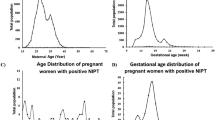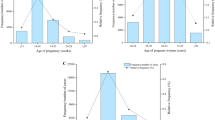Abstract
Objectives
The use of cell-free fetal deoxyribonucleic acid (DNA) requires the knowledge of variables that may influence the levels of cell-free DNA, such as maternal body mass index (BMI).
Material and methods
In this study, using 406 maternal blood samples from the second trimester of pregnancy, cell-free fetal DNA specific for the SRY and DYS14 loci and glyceraldehyde-3-phosphate dehydrogenase sequence were quantified by real-time polymerase chain reaction.
Results
No significant correlation was seen between the levels of cell-free fetal DNA and maternal BMI, whereas total cell-free DNA was significantly associated with maternal BMI at 20 to 21 weeks of gestation (P = .034) and at the end of pregnancy (R2 regression: 0.016, P = .014).
Conclusion
Quantitative levels of cell-free fetal DNA are not affected by maternal BMI, whereas total DNA levels in the second trimester significantly correlate with maternal BMI at the moment of blood drawing and at delivery.
Similar content being viewed by others
References
Lo YM. Fetal DNA in maternal plasma: biology and diagnostic applications. Clin Chem. 2000;46:1903–1906.
Maron JL, Bianchi DW. Prenatal diagnosis using cell-free nucleic acids in maternal body fluids: a decade of progress. Am J Med Genet C Semin Med Genet. 2007;145:5–17.
Dennis Lo YM, Chiu RW. Noninvasive prenatal diagnosis of fetal chromosomal aneuploidies by maternal plasma nucleic acid analysis. Clin Chem. 2008;54:461–466.
Jorgez CJ, Dang DD, Wapner R, Farina A, Simpson JL, Bischoff FZ. Elevated levels of total (maternal and fetal) beta-globin DNA in maternal blood from first trimester pregnancies with trisomy 21. Hum Reprod. 2007;22:2267–2272.
Farina A, Sekizawa A, Iwasaki M, Matsuoka R, Ichizuka K, Okai T. Total cell-free DNA (beta-globin gene) distribution in maternal plasma at the second trimester: a new prospective for preeclampsia screening. Prenat Diagn. 2004;24:722–726.
Zhong XY, Laivuori H, Livingston JC, et al. Elevation of both maternal and fetal extracellular circulating deoxyribonucleic acid concentrations in the plasma of pregnant women with preeclampsia. Am J Obstet Gynecol. 2001;184: 414–419.
Diesch CH, Holzgreve W, Hahn S, Zhong XY. Comparison of activin A and cell-free fetal DNA levels in maternal plasma from patients at high risk for preeclampsia. Prenat Diagn. 2006;26:1267–1270.
Catalano PM. Increasing maternal obesity and weight gain during pregnancy: the obstetric problems of plentitude. Obstet Gynecol. 2007;110:743–744.
DeVader SR, Neeley HL, Myles TD, Leet TL. Evaluation of gestational weight gain guidelines for women with normal prepregnancy body mass index. Obstet Gynecol. 2007;110: 745–751.
Kiel DW, Dodson EA, Artal R, Boehmer TK, Leet TL. Gestational weight gain and pregnancy outcomes in obese women: how much is enough? Obstet Gynecol. 2007;110: 752–758.
Cedergren MI. Optimal gestational weight gain for body mass index categories. Obstet Gynecol. 2007;110:759–764.
de Graaf IM, Cuckle HS, Pajkrt E, Leschot NJ, Bleker OP, van Lith JM. Co-variables in first trimester maternal serum screening. Prenat Diagn. 2000;20:186–189.
Spencer K, Bindra R, Nicolaides KH. Maternal weight correction of maternal serum PAPP-A and free beta-hCG MoM when screening for trisomy 21 in the first trimester of pregnancy. Prenat Diagn. 2003;23:851–855.
Lapaire O, Volgmann T, Huang D, Hahn S, Holzgreve W, Xiao Zhong Y. Maternal smoking: effect on circulating cell-free fetal and total DNA levels in maternal plasma from the second trimester. Obstet Gynecol. 2007;110:1358–1363.
Zimmermann B, El-Sheikhah A, Nicolaides K, Holzgreve W, Hahn S. Optimized real-time quantitative PCR measurement of male fetal DNA in maternal plasma. Clin Chem. 2005;51: 1598–1604.
Zhong XY, Holzgreve W, Hahn S. Risk free simultaneous prenatal identification of fetal rhesus D status and sex by multiplex real-time PCR using cell free fetal DNA in maternal plasma. Swiss Med Wkly. 2001;131:70–74.
Lo YM, Tein MS, Lau TK, et al. Quantitative analysis of fetal DNA in maternal plasma and serum: implications for noninvasive prenatal diagnosis. Am J Hum Genet. 1998;62: 768–775.
Hahn S, Huppertz B, Holzgreve W. Fetal cells and cell free fetal nucleic acids in maternal blood: new tools to study abnormal placentation? Placenta. 2005;26:515–526.
Bianchi DW. Circulating fetal DNA: its origin and diagnostic potential—a review. Placenta. 2004;25:S93–S101.
Zhong XY, Holzgreve W, Gebhardt S, et al. Minimal alteration in the ratio of circulatory fetal DNA to fetal corticotropin-releasing hormone mRNA level in preeclampsia. Fetal Diagn Ther. 2006;21:246–249.
Sorensen T, Larsen SO, Christiansen M. Weight adjustment of serum markers in early first-trimester prenatal screening for Down syndrome. Prenat Diagn. 2005;25:484–488.
Robinson HE, O’Connell CM, Joseph KS, McLeod NL. Maternal outcomes in pregnancies complicated by obesity. Obstet Gynecol. 2005;106:1357–1364.
Bhattacharya S, Campbell DM, Liston WA, Bhattacharya S. Effect of body mass index on pregnancy outcomes in nulliparous women delivering singleton babies. BMC Public Health. 2007;7:168.
Wataganara T, Peter I, Messerlian GM, Borgatta L, Bianchi DW. Inverse correlation between maternal weight and second trimester circulating cell-free fetal DNA levels. Obstet Gynecol. 2004;104:545–550.
Huppertz B, Frank HG, Kingdom JC, Reister F, Kaufmann P. Villous cytotrophoblast regulation of the syncytial apoptotic cascade in the human placenta. Histochem Cell Biol. 1998;110:495–508.
Wataganara T, Metzenbauer M, Peter I, Johnson KL, Bianchi DW. Placental volume, as measured by 3-dimensional sonography and levels of maternal plasma cell-free fetal DNA. Am J Obstet Gynecol. 2005;193:496–500.
Author information
Authors and Affiliations
Corresponding author
Rights and permissions
About this article
Cite this article
Lapaire, O., Volgmann, T., Grill, S. et al. Significant Correlation Between Maternal Body Mass Index at Delivery and in the Second Trimester, and Second Trimester Circulating Total Cell-free DNA Levels. Reprod. Sci. 16, 274–279 (2009). https://doi.org/10.1177/1933719108327599
Published:
Issue Date:
DOI: https://doi.org/10.1177/1933719108327599




